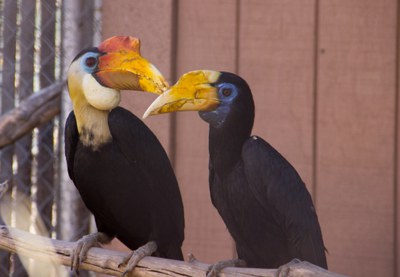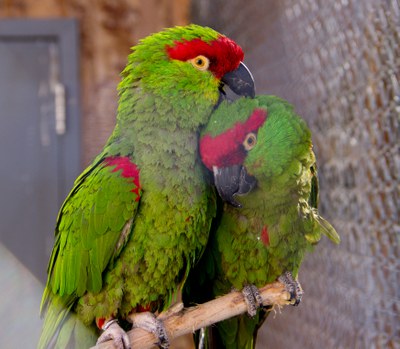Love is for the birds
 Wrinkled hornbills
Wrinkled hornbills
Picky lover
The ABQ BioPark Zoo’s two wrinkled hornbills have an interesting relationship—the male feeds the female and she spits it out.
Her selectivity is common in birds—she has much of the power in the relationship, even when it comes to gender of the baby. Unlike humans, it is the female bird's chromosomes that decide whether a chick is male or female.
Matters of relationship power aside, the two seem to enjoy each other’s company—they follow each other from branch to branch and even engage in a little flirtatious “bill slapping” (this is when the two birds gently “slap” bills with each other). The two even successfully bred in 2014.
Males of this species might seem a little controlling once the female becomes pregnant—they actually “mud” the females into a hole in a tree and feed them through a slit. This is the species' nesting protocol, however, and BioPark staff help encourage it by providing a nest and some mud for the couple.
Wrinkled hornbills are critically endangered, and the ABQ BioPark hopes its pair will produce another chick. The odds look good, as romance seems to be in the air for these two.
 Thick-billed parrots
Thick-billed parrots
Love at first sight
The ABQ BioPark’s two thick-billed parrots seem to enjoy each other’s company—Duke, the male, enjoys grooming the female. The two were introduced in 2012, and zookeepers said of the two, “It was love at first sight.”
The Zoo hopes to breed the two—thick-billed parrots are an endangered species that is native to New Mexico and Arizona, but there has not been a verifiable sighting of the species in the Southwest since 1938. There are about 3,000 still living in Mexico.
In the late 80s, conservationists attempted to reintroduce thick-billed parrots into the wild in the Southwest, but it was largely unsuccessful. The challenge lies in numbers—they need to be released as a flock, said Diane Longenecker, senior zookeeper (previous attempts have released them in pairs). This is because more eyes looking out for each other means easier survival in the wild.

